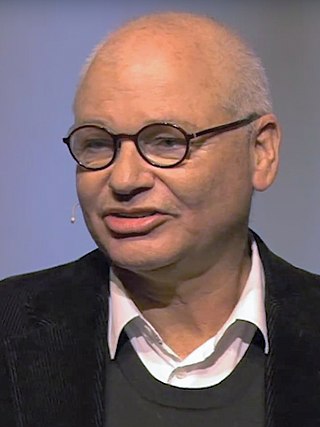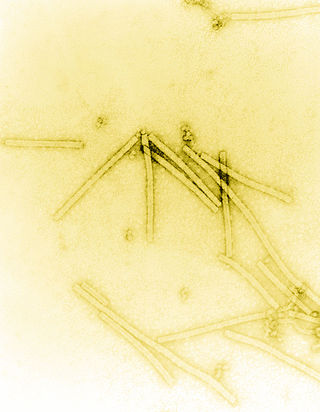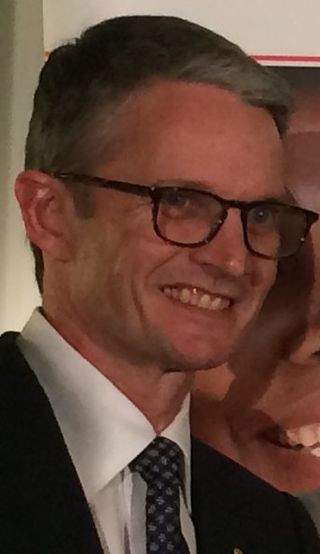Related Research Articles
The National Institute of Allergy and Infectious Diseases is one of the 27 institutes and centers that make up the National Institutes of Health (NIH), an agency of the United States Department of Health and Human Services (HHS). NIAID's mission is to conduct basic and applied research to better understand, treat, and prevent infectious, immunologic, and allergic diseases.

CSL Limited is an Australian multinational specialty biotechnology company that researches, develops, manufactures, and markets products to treat and prevent serious human medical conditions. CSL's product areas include blood plasma derivatives, vaccines, antivenom, and cell culture reagents used in various medical and genetic research and manufacturing applications. The company was established in 1916 as Commonwealth Serum Laboratories and was wholly owned by the Australian federal government until its privatisation in 1994.
The Hong Kong flu, also known as the 1968 flu pandemic, was a flu pandemic that occurred in 1968 and 1969 and which killed between one and four million people globally. It is among the deadliest pandemics in history, and was caused by an H3N2 strain of the influenza A virus. The virus was descended from H2N2 through antigenic shift, a genetic process in which genes from multiple subtypes are reassorted to form a new virus.

Thomas Francis Jr. was an American physician, virologist, and epidemiologist who guided the discovery and development of the polio vaccine being worked on by his student Jonas Salk. Francis was the first person to isolate influenza virus in the United States, and in 1940 showed that there are other strains of influenza, and took part in the development of influenza vaccines.

Maurice Ralph Hilleman was a leading American microbiologist who specialized in vaccinology and developed over 40 vaccines, an unparalleled record of productivity. According to one estimate, his vaccines save nearly eight million lives each year. He has been described as one of the most influential vaccinologists ever. He has been called the "father of modern vaccines". Robert Gallo called Hilleman "the most successful vaccinologist in history". He has been noted by some researchers as having saved more lives than any other scientist in the 20th century.
The National Microbiology Laboratory (NML) is part of the Public Health Agency of Canada (PHAC), the agency of the Government of Canada that is responsible for public health, health emergency preparedness and response, and infectious and chronic disease control and prevention.
Donald Pinkston Francis is an American physician and epidemiologist who worked on the Ebola outbreak in Africa in the late 1970s, and as an HIV/AIDS researcher. He retired from the U.S. Public Health Service in 1992, after 21 years of service. He lives in San Francisco, California.
The Burnet Institute is an Australian medical institute that combines medical research in the laboratory and the field, with public health action to address major health issues affecting disadvantaged communities in Australia, and internationally.

Jaap Goudsmit is a Dutch scientist, known for his research in the field of AIDS and influenza. He shifted his research interest to aging and neurodegenerative diseases, like Alzheimer's Disease. He is also a prolific writer of non-fiction books: Viral Sex, the Nature of AIDS (1997); Viral Fitness, the Next SARS and West Nile in the Making (2004); Serendipity Manual (2012); The Vaccine Bug, a personal history of the World of Immunity (2013); Immorbidity Alphabet, Spelling-out a life free of dis-ease (2015); The Time of your Life, Staying healthy to the End (2016) and The Art of Facing Mortality, a scientist's view (2016).

Hepatitis B vaccine is a vaccine that prevents hepatitis B. The first dose is recommended within 24 hours of birth with either two or three more doses given after that. This includes those with poor immune function such as from HIV/AIDS and those born premature. It is also recommended that health-care workers be vaccinated. In healthy people, routine immunization results in more than 95% of people being protected.
The National Institute of Virology in Pune, India is an Indian virology research institute and part of the Indian Council of Medical Research (ICMR). It was previously known as 'Virus Research Centre' and was founded in collaboration with the Rockefeller Foundation. It has been designated as a WHO H5 reference laboratory for SE Asia region.

The history of virology – the scientific study of viruses and the infections they cause – began in the closing years of the 19th century. Although Edward Jenner and Louis Pasteur developed the first vaccines to protect against viral infections, they did not know that viruses existed. The first evidence of the existence of viruses came from experiments with filters that had pores small enough to retain bacteria. In 1892, Dmitri Ivanovsky used one of these filters to show that sap from a diseased tobacco plant remained infectious to healthy tobacco plants despite having been filtered. Martinus Beijerinck called the filtered, infectious substance a "virus" and this discovery is considered to be the beginning of virology.

Fairfield Infectious Diseases Hospital, originally known as Queens Memorial Infectious Diseases Hospital, operated from 1904 to its closure in 1996. Perched high on the banks of the Yarra River at Yarra Bend in the inner Melbourne suburb of Fairfield, it developed an international reputation for the research and treatment of infectious diseases. When it closed, it was the last specific infectious diseases hospital in Australia.

Robert Merritt Chanock was an American pediatrician and virologist who made major contributions to the prevention and treatment of childhood respiratory infections in more than 50 years spent at the National Institute of Allergy and Infectious Diseases.

Brendan Scott Crabb is an Australian microbiologist, research scientist and director and chief executive officer of the Burnet Institute, based in Melbourne, Victoria, Australia.

George Keble Hirst, M.D. was an American virologist and science administrator who was among the first to study the molecular biology and genetics of animal viruses, especially influenza virus. He directed the Public Health Research Institute in New York City (1956–1981), and was also the founding editor-in-chief of Virology, the first English-language journal to focus on viruses. He is particularly known for inventing the hemagglutination assay, a simple method for quantifying viruses, and adapting it into the hemagglutination inhibition assay, which measures virus-specific antibodies in serum. He was the first to discover that viruses can contain enzymes, and the first to propose that virus genomes can consist of discontinuous segments. The New York Times described him as "a pioneer in molecular virology."
Werner Henle and Gertrude Henle were a husband and wife team of German-American virologists. The National Library of Medicine called them "a prodigious force in virology, immunology and viral oncology during the second half of the 20th century".
Margaret Sabine (1928–2011) was the pioneering virologist for Australian veterinary schools. She conducted studies on viruses in cats and horses, with her characterisation of different equine viruses being her most significant scientific contribution. Other achievements include becoming head of the department of veterinary pathology and bacteriology, being chairwoman of the NSW Animal Welfare Advisory Council, an honorary Veterinary Science degree at the University of Sydney, and being a co-discoverer of viral interference.

Guan Yi is a Chinese virologist. In 2014, he was ranked as 11th in the world by Thomson Reuters among global researchers in the field of microbiology. He obtained his PhD in microbiology at the University of Hong Kong and is now a professor of microbiology at his alma mater. His research on the viral respiratory disease SARS helped the Chinese government avert the 2004 outbreak of this disease. He is the current director of the State Key Laboratory for Emerging Infectious Diseases University of Hong Kong. In early 2017, Guan warned that the H7N9 influenza virus "poses the greatest threat to humanity than any other in the past 100 years".
References
- 1 2 3 Walker, Rosanne (30 June 1997). "Gust, Ian David (1941 - )". Encyclopedia of Australian Science. Retrieved 11 April 2012.
- ↑ "Professor Ian Gust". Vaccine and Immunotherapy Technologies. Sir Mark Oliphant Conferences. 2008. Archived from the original on 10 April 2013. Retrieved 11 April 2012.
- 1 2 "Board of Directors & Senior Management". Biota Holdings Limited. 2006. Retrieved 11 April 2012.
- ↑ "Biota Holdings Limited: Executive Profile: Ian David Gust". Bloomberg Businessweek. 11 April 2012. Retrieved 11 April 2012.[ dead link ]
- ↑ Gust, Ian (4 June 2006). "Professor Ian Gust". Big Ideas (Interview: transcript). Interviewed by Terry Lane. Australia: ABC Radio National . Retrieved 11 April 2012.
- ↑ "Gust, Ian David". It's an honour. Commonwealth of Australia. 8 June 1992. Retrieved 11 April 2012.